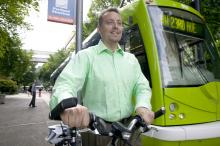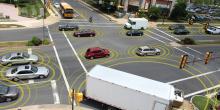
For ITS to gain the recognition it deserves,
Any industry or group of people will develop its own lexicon over time. The process is near-inevitable, as individuals’ knowledge bases increase and evolve, and terms for common wisdom are created and become truncated, or even slang. A danger, though, as a relatively small group looks to admit large numbers of new members, or else share its knowledge with the wider world, is that it risks sending out confused messages about what it is and does, and the contribution it can make to society in the wider sense. The ITS industry, which remains a small group in global terms, is in danger of doing that, especially within a Smart City context.
Smart City concepts were one of the two main buzz-themes at this year’s
The ITS industry is now comfortably into its third decade of existence. Yet, in many respects, we still have not truly pinned down what ‘ITS’ stands for. The ‘I’ is commonly accepted to mean ‘Intelligent’, although many would suggest that ‘Integrated’ is becoming evermore appropriate. ’T’ – ‘Transport’ or ‘Transportation’, according to preference – is straightforward. The ‘S’, once ‘Systems’, is now more widely accepted to mean ‘Services’, as the realisation grows that it is the end delivery, and not the technology, which is the industry’s greater aim. Nor have we decided exactly what an ‘ITS’ system is. Presumably, any piece of technology or individual application which helps to improve transport systems’ health and performance could be described as ITS, although some of the technologies and applications which would fit that description are only peripherally linked to transport infrastructure management.
Realising progress
Within its ‘core’ technologies the ITS industry is reaching a point of maturity, after some considerable time and effort. Many of the concepts which were at the heart of those fledgling studies are close to being realised. We are on the verge of deploying autonomous vehicles – indeed, some are already out there, conducting real-world trials in circumstances which have received little fanfare. Other projects, such as the Google Self-Driving Car (SDC) and Tesla’s Autopilot, have enjoyed rather more publicity.
Inevitably, along the way, we have seen significant changes.
The Vehicle Infrastructure Integration (VII) programme, the US’s original connected vehicle venture, provides an example and a starting point. It began as a relatively limited, vehicle-only concept which took little regard of personalised mobility. Over the years, we have seen several renamings and more recently an increasing emphasis on the individual traveller. The upswell in smart nomadic devices is a factor here and this has brought about a consideration of a wider range of connectivity standards and protocols beyond just 5.9GHz DSRC. Indeed, recent years have seen officials from the USDOT’s ITS Joint Program Office and ITS America become regular visitors to the CE Show in Las Vegas, in order to gain an appreciation of consumer electronics’ influence on mobility.
By contrast, the European Union’s (EU’s) approach was from the outset more multimodal and technology-agnostic in nature, and based on the CALM stack of protocols which includes 5.9GHz as well as numerous others.
The maturation/evolution of VII demonstrates the many aspects of modern mobility which have to be taken into consideration. The contrast between the initial forms of connected mobility projects within a car-centric society - the US - and one more oriented to multimodality - the EU - provides food for thought. It forms the basis for some of the current terminological confusion.
Step back out into the wider world for a moment. To the uninitiated, current and future vehicle developments present a bewilderingly complex face, and there have been understandable misconceptions and assumptions. Keen media interest in the SDC and Autopilot, for example, has entrenched in the public’s mind that driver-less vehicles are the immediate next step. This ignores the fact that much research has gone on into semi-autonomous and driver assistance solutions and applications.
Driverless vehicles, arguably the culminating point of the ITS effort started all those years ago, could still yet be several years and steps away, if only because our legislative environment and user acceptance have so far failed to keep pace with technological development.
Misconceptions are common. They are also reinforced by mass media outlets keen to provoke both interest and controversy. This is compounded by the fact that, despite having more media outlets than ever before, the specialist journalist within the mass media environment is a dying breed; these days, the generalist holds sway.
Confluence and conflict
Happily, the enthusiastic - and necessary - international cooperation within the ITS sector has resulted in a confluence of thinking. US, European and Far Eastern programmes are now more in step conceptually, even if not temporally. We are left, though, with a major house keeping effort to address in terms of terminology. Nor are we talking about legacy terminology; in many cases it is the emerging labels and titles that give rise to the most concern.
Until recently, we were talking about Vehicle-to-Vehicle (V2V), Vehicle-to-Infrastructure (V2I) or Vehicle-to-Device (V2X). The fortunes of all three have waxed and waned in line with economic conditions - V2V has made strides in recent years, while V2I has stalled somewhat as major infrastructure programmes have been delayed. Nevertheless, austerity has driven creativity and ongoing technological progress and policy shifts have strengthened V2X’s prospects.
The recent arrival is Cooperative ITS (C-ITS), a term which covers the ‘V trinity’ really rather well. It describes an environment in which people, vehicles and goods interrelate with each other and infrastructure to maximise safety and environmental performance while increasing efficiency and reducing cost.
In the US, in line with the current incarnation of what was VII, the term Connected Vehicle is in common use. Although the divisions are not as stark as they once were, Connected Vehicle remains more 5.9GHz-oriented and even within the US there are differing opinions as to exactly what ‘Connected Vehicle’ means. The situation is not helped by C-ITS also being used to describe multimodality in the wider sense, as in Europe.
We can add to the list ‘Infomobility’, which is perhaps best considered to be a subset of C-ITS and, more recently, the European Commission, through DG MOVE, has been supporting ‘Urban ITS’ projects. This latter term also overlaps with, and carries out many of the same functions as, C-ITS.
Wider perspectives
Even within the ITS sector, then, there is the potential for confusion. If we then look to place ITS (or C-ITS/Connected Vehicle/Infomobility/Urban ITS) within the wider Smart City context, the potential for confusion becomes even greater, as we look to interact with a far larger community.This is unfortunate, as Smart Cities are a major part of ITS’s future. One could even argue that ITS faces the prospect of eventually becoming a subset of the Smart City environment, so it is important to get things right.
Smart Cities are already well established within the ITS industry’s collective con-sciousness — the interest expressed in Bordeaux underlines that. The premise is a good one: by breaking down the traditional institutional barriers within the administrations of our larger settlements and engaging in greater data interchange and fusion, synergies will be achieved that perform far greater than the constituent parts ever could. There is an easy correlation to be made with the ITS sector’s moves towards multimodality over the last decade and more and, indeed, what ITS has done can be regarded as a precursor of what town and city administrations are looking to do in a much wider sense.
There is a huge reliance on ever-greater quantities of accurate, real-time data and many of the tools are common; greenfield development aside, it is prohibitively expensive for cities to completely replace existing infrastructures. The solution therefore has to be an overlay of smart devices — C-ITS in a much larger, multifaceted form. In time, the same will hold true in inter-urban and rural areas. There is in fact a greater technology need per capita in more sparsely populated areas, as there is less opportunity to share common infrastructure.
The ITS sector, then, has in many ways laid the groundwork for Smart Cities’ success, and there is validity in ITS forming the basis of many Smart City projects, given that mobility and related services underpin so much of our lives. It is important, though, if we are to more quickly break down barriers and save time, to make sure that we are all talking about the same things in the same terms.












